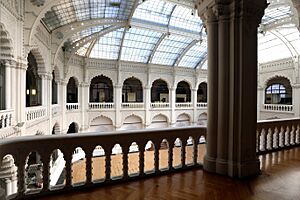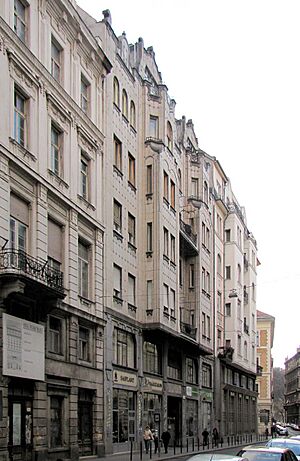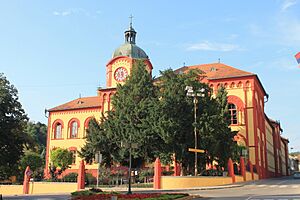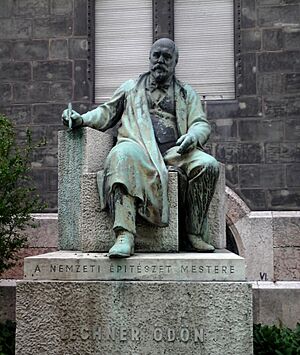Ödön Lechner facts for kids
Quick facts for kids
Ödön Lechner
|
|
|---|---|
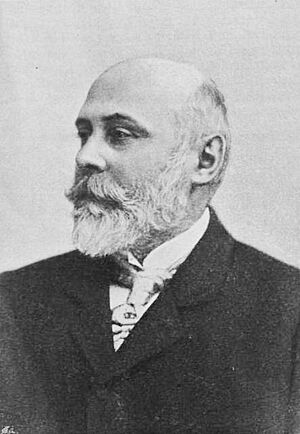 |
|
| Born |
Eugen Lechner
27 August 1845 Pest, Austrian Empire
|
| Died | 10 June 1914 (aged 68) Budapest, Austria-Hungary
|
| Other names | "Hungarian Gaudí" |
| Alma mater | Schinkel Academy |
| Occupation | Architect |
| Spouse(s) | Irma Primayer |
| Children | János Ödön Irma |
| Parent(s) | Johann Lechner Theresia Schummayer |
| Buildings | Headquarters, National Bank of Hungary Museum of Applied Arts |
Ödön Lechner (born Eugen Lechner; 27 August 1845 – 10 June 1914) was a famous Hungarian architect. He was a main leader of the Hungarian Szecesszió style. This style was similar to Art Nouveau in other parts of Europe.
Lechner is known for decorating his buildings with special Zsolnay tiles. These tiles had patterns inspired by old Hungarian and Turkic folk art. He combined these traditional designs with new materials like iron.
In 2008, Lechner's work was suggested to be added to the World Heritage List. This list includes places around the world that are very important.
Contents
Early Life and Studies
Lechner was born in Pest, a city that is now part of Budapest. His father was a lawyer and owned a brick factory. Ödön began studying architecture in 1865. He attended the Budapest University of Technology and Economics.
In 1866, Lechner went to Berlin, Germany. He studied at the Academy of Architecture for three years. There, he learned a lot about building materials, especially how to use iron in structures.
After his studies, Lechner traveled to Italy in 1868 with his wife, Irma Primayer. In 1869, he started an architecture company with Gyula Pártos. They designed many apartment buildings in Pest. At first, Lechner used a style called historicist, which copied older styles like those from the Italian Renaissance.
Between 1874 and 1878, Lechner worked in France. He helped restore many old French buildings and castles. This was a difficult time for him, as he lost his wife in 1875. He was left to care for their two young children. In 1879, he also visited England.
When he returned home, he worked with Pártos again. They built large projects like the Szeged City Hall (1882). Even in these older style buildings, you can see hints of his later unique art. In 1889, he visited England again with Vilmos Zsolnay. Zsolnay made stoneware and terracotta. Lechner studied Asian ceramics and Indian designs at the Victoria and Albert Museum.
Developing a Hungarian Style
After 1890, Lechner started to use Hungarian folk art as his main inspiration. He wanted to create a truly Hungarian style of architecture. His partnership with Zsolnay grew stronger. He began to use Zsolnay's colorful tiles on his buildings.
One of his first buildings with these tiles was the Thonet House in Budapest (1889). It had a steel frame and a facade covered in Zsolnay terracotta.
His most famous work is the Museum of Applied Arts (1893–96). Lechner and Pártos won the design competition for this building. Its glazed tiles and special decorations show Lechner's new style. He mixed Indian, Persian, Moorish, and Hungarian folk influences.
This building was very different from other buildings in Budapest at the time. It was finished in time for Hungary's millennium celebration in 1896. Today, it is seen as the first complete example of Hungarian Szecesszió (Art Nouveau) architecture. It was a unique style for Hungary within the Austro-Hungarian Empire.
After 1896, Lechner and Pártos worked separately. In 1897, Lechner designed the new Geological Museum. This was another building in his special Szecesszió style.
His unique designs reached their peak with the Royal Postal Savings Bank (1899–1904). This building is now the Hungarian State Treasury. For his work, Lechner received a "Royal Counselor" title and a Grand Gold Medal.
Lechner also designed churches. One important church is the Catholic Church of St. Elizabeth in Bratislava (1907–13). It is a very colorful and lively Szecesszió design.
Later Years and Influence
In 1911, Lechner won a gold medal at an architecture exhibition in Rome. He shared the award with Otto Wagner, a famous Austrian architect. In his later years, Lechner took on smaller projects. He also wrote about his ideas in a journal called Művészet in 1906.
Even though he didn't get many large projects later on, his unique Szecesszió style inspired many other architects in Hungary. Some of his followers included Béla Lajta and István Medgyaszay.
Buildings and Projects
- 1870: Batthyány Tomb
- 1871–74: Apartment building, Budapest V., Szent István tér 3
- 1874–75: Kecskemét Savings Bank, Kecskemét
- 1882–83: City Hall, Szeged (with Gyula Pártos)
- 1882–84: Hungarian Railway Pensioners Building (Palais Drechsler), Budapest (with Pártos)
- 1885–86: Nagybecskerek City Hall, (today's Zrenjanin, Serbia) (with Pártos)
- 1888–89: Thonet House, Budapest V., Váci u. 11
- 1889–91: Karlovci Gymnasium, Karlóca (now Sremski Karlovci, Serbia) (with Pártos)
- 1890–96: Kecskemét City Hall, Kecskemét (with Pártos)
- 1891–96: Budapest Museum of Applied Arts, Budapest IX.
- 1891–97: Saint Ladislaus Church (Szent László-plébániatemplom), Kőbánya, Budapest X.
- 1896–99: Geological Institute, Budapest
- 1899–1901: The Postal Savings Bank building (Postatakarékpénztár), Budapest
- 1907–13: The Church of St. Elizabeth (Blue Church) in Pozsony (today's Bratislava)
- 1910–11: Gyula Vermes House, Budapest
- 1914–15: Szent László Gimnázium, Budapest
Images for kids
-
City Hall, Szeged (1882)
-
City Hall, Kecskemét (1893)
-
Gymnázium Grösslingová in Pozsony (Pressburg) (today's Bratislava) (1906–08)
Monuments and Memorials
- The Ödön Lechner Society was created in 1928 to honor him. Famous people like Béla Bartók were part of it.
- You can find statues of Lechner in front of the Museum of Applied Arts in Budapest and in Kőbánya.
- A bust (a sculpture of his head and shoulders) of Lechner is in Szeged.
- Many streets and squares in Hungarian cities are named after him.
- Lechner is buried in the Fiumei Úti Tomb Garden in Budapest.
See also
 In Spanish: Ödön Lechner para niños
In Spanish: Ödön Lechner para niños


